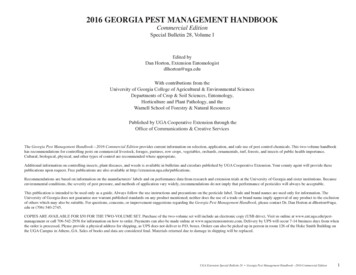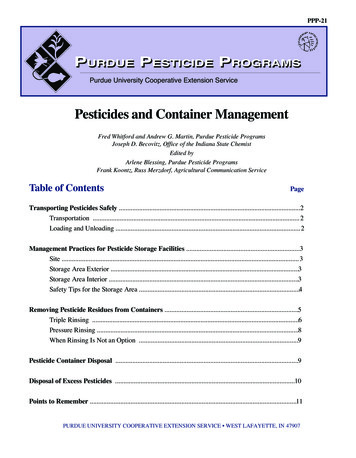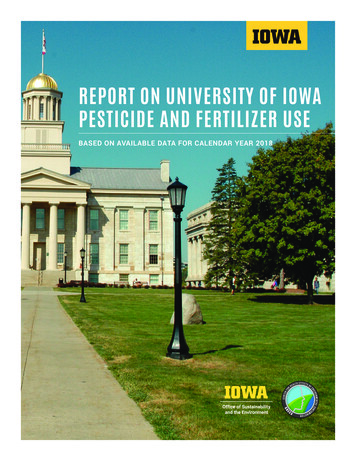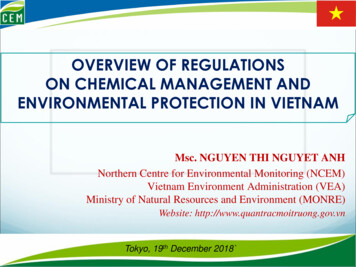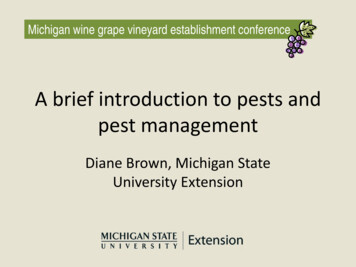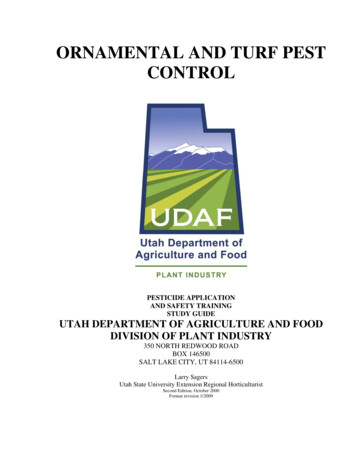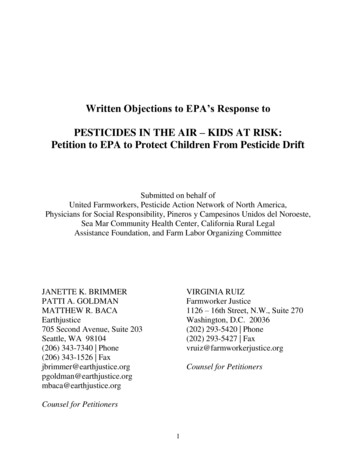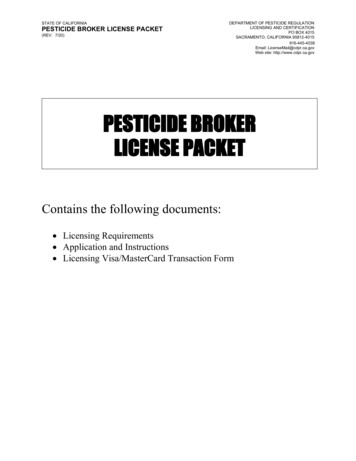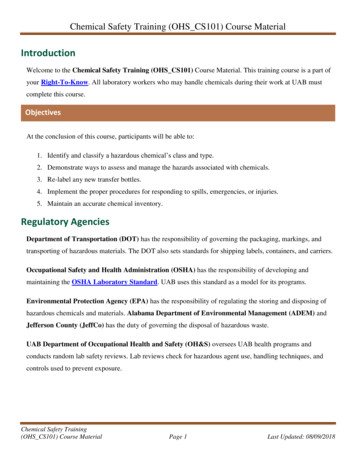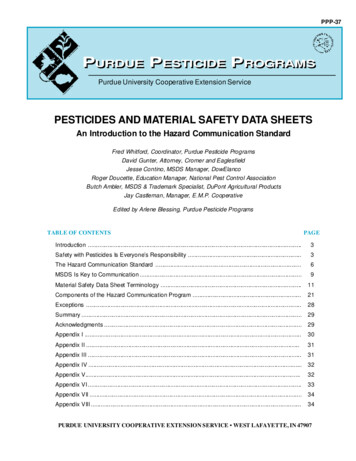
Transcription
PPP-37PURDUEURDUE PESTICIDEESTICIDE PROGRAMSROGRAMSPurdue University Cooperative Extension ServicePESTICIDES AND MATERIAL SAFETY DATA SHEETSAn Introduction to the Hazard Communication StandardFred Whitford, Coordinator, Purdue Pesticide ProgramsDavid Gunter, Attorney, Cromer and EaglesfieldJesse Contino, MSDS Manager, DowElancoRoger Doucette, Education Manager, National Pest Control AssociationButch Ambler, MSDS & Trademark Specialist, DuPont Agricultural ProductsJay Castleman, Manager, E.M.P. CooperativeEdited by Arlene Blessing, Purdue Pesticide ProgramsTABLE OF CONTENTSPAGEIntroduction .3Safety with Pesticides Is Everyone’s Responsibility .3The Hazard Communication Standard .6MSDS Is Key to Communication .9Material Safety Data Sheet Terminology .11Components of the Hazard Communication Program .21Exceptions .28Summary .29Acknowledgments .29Appendix I .30Appendix II .31Appendix III .31Appendix IV .32Appendix V.32Appendix VI .33Appendix VII .34Appendix VIII .34PURDUE UNIVERSITY COOPERATIVE EXTENSION SERVICE WEST LAFAYETTE, IN 47907
INTRODUCTIONDuring the past several decades, there has been agrowing awareness of the importance of safety inAmerican industry. This awareness has been brought intosharper focus by the news media, government, and thepublic, triggered in part by major chemical accidents suchas the Bhopal, India, chemical explosion in 1984. Suchtragic events evoke a painful appreciation of the high cost tobusiness and society when safety is not adequatelyaddressed.Safety is no less an issue for the pest control industry.Government regulation and industry programs placeemphasis on the safe manufacture, distribution, use, anddisposal of pesticides. Examples of government action: theOccupational Safety and Health Administration (OSHA)Hazard Communication Standard; and EnvironmentalProtection Agency regulations under the EmergencyPlanning and Community Right-to-Know Act. On theindustry side, there is the Responsible Care Program of theChemical Manufacturers Association.This publication focuses on the role of the material safetydata sheet (MSDS), a key element of OSHA’s HazardCommunication Standard, in providing guidance anddirection for safer manufacture and handling of pesticides.In addition, product labeling, worker training, and workeraccess to chemical hazard information are addressed.SAFETY WITH P ESTICIDES I S EVERYONE’SRESPONSIBILITYWell Trained Workers Are NecessaryToday’s pest control industry is highly competitive.Therefore, employers must hire and retain highly skilledindividuals to perform the multitude of tasks associated withmanufacturing, distributing, handling, and storing pesticides.Most managers realize that employees do not become“skilled” overnight; experience is essential to proficiency.Educational training programs serve to develop skills,improve worker competency, and promote job awarenessand productivity.Delivering a competitive, quality pest control servicerequires more than simply knowing how to control pests.Employee safety training programs are critical in reducingtransportation accidents, preventing off-target pesticidemovement, demonstrating the proper use of personalprotective equipment, and averting monetary losses andinjuries to workers caused by pesticide spills or releases.There are other benefits, too. Employees who fully understand their jobs will assist in reducing losses from regulatory3
fines, employee lawsuits, hazardous waste cleanups,worker compensation claims, and property damage suits.Time and money spent on providing safety and job performance training will pay big dividends by reducing productionlosses, boosting company profitability, and facilitatingemployee retention.Employer’s Commitment to Pesticide SafetyPesticide-related businesses need to conduct regular, indepth audits to identify all potential chemical hazardson the premises and at job sites; and more than applicationprocedures alone must be recognized as potential risks. Forinstance, pesticide storage, container rinsing and disposal,excess product disposal, and the transportation of hazardous chemicals all carry a risk potential.Audits alert employers to the presence of hazardouschemicals and practices which should be corrected throughalternative chemical selection and the implementation ofsafety programs to reduce risk potential.Putting safety programs in place and practicing pesticidesafety require an aggressive and continuous commitment bymanagement. This is facilitated by educating the work forceto focus on and implement safety strategies. Workers mustunderstand that their adherence to safety protocol4
developed by an employer is mandatory for long-termemployment. Employers who openly share information withemployees and mandate safety rule compliance communicate to their workers, in effect, that they are concernedabout their safety and well being.Employees Must Share ResponsibilityEmployees play a major role in fostering safety in theworkplace; employers cannot maintain a safe workingenvironment without the full cooperation and active involvement of their workers. Employees must be trained torecognize potential safety problems, to avert those problems, and to exercise appropriate steps to prevent exposureto pesticides and other hazardous materials. Written company policy should state that much of the responsibility formaintaining safety in the workplace rests on the employeesthemselves; and it should be stressed that a pesticide safetyprogram is only as good as the commitment of employeesto take it seriously.Employees must be constantly alert to safety concernsand understand that the greatest threat to their well-beingoccurs when they do not follow prescribed safety practicesin the workplace. Not only should workers recognize potential problems and how to prevent them, they also must beprepared to respond to chemical emergencies such aspesticide warehouse fires, accidental poisonings, and tankruptures on service vehicles. Preventive strategies and athorough knowledge of proper reactionary steps are essential components of pesticide safety policies.Failure to recognize the potentially serious consequences of a pesticide emergency can, in itself, provecatastrophic. Employees who ignore safety practicesincrease the likelihood of injury to themselves and others.Loss of income, the cost of medical treatment, and job lossresulting in financial strain are potential consequences ofeven a minor safety problem. Also, negative publicity from asafety-related incident can damage the company’sreputation.Pesticide Safety Is a Shared ResponsibilityAll jobs involving pesticides—indoors or outdoors,manufacturing or service—carry a hazard potential.Conscious responsibility for the safe transportation, storage,and handling of pesticides and other hazardous materialsmust be assumed at every level: manufacturing facilities,distribution outlets, and application industries. Each segment of the pesticide industry bears the responsibility toconduct its business in a manner whereby employees aretrained and safe work practices are in place.Both labor and management bear safety responsibilities.Both must commit to job safety each and every day through5
practice and communication. Today’s increased focus onand attention to safety considerations require that everyoneassociated with pesticides (janitor, secretary, supervisor,applicator, etc.) have some knowledge of the products beingstored and handled within the business. The responsibilityfor using pesticides safely—that is, taking the steps necessary to protect human health and the environment—cannotbe taken lightly by either labor or management.THE H AZARD COMMUNICATION STANDARDOver time, state and federal government has assumedmore and more responsibility for ensuring that workersare provided a safe working environment. The OccupationalSafety and Health Act of 1970 led to the creation of theOccupational Safety and Health Administration (OSHA)within the United States Department of Labor. The Occupational Safety and Health Act consolidated many of theexisting federal worker safety laws under the OSHA umbrella. This law also authorized the establishment of regulations to ensure that employees are provided information onthe hazards to which they may be exposed, and thatprecautions are taken to prevent or reduce exposure tohazardous chemicals.The Occupational Safety and Health Act also providesOSHA with a mechanism for entering into cooperativeagreement with state agencies to enforce worker protection6
rules within the states’ boundaries. Federal and stateprograms mandate safety in the workplace, throughregulations, and promote such safety through educationaland technical assistance.OSHA enacted the federal Hazard CommunicationStandard (HCS) (29 CFR 1910.1200) in 1983. Only employees in manufacturing industries were covered by the originalversion of HCS; but in 1989 it was expanded to cover allemployees who (potentially) may be exposed to hazardouschemicals in their work areas—regardless of the place ofemployment or nature of the industry.The HCS is the cornerstone of each employee’s right-toknow. Its strategy is to ensure that hazardous chemicals arefully evaluated and their hazards communicated to workersby means of labels, material safety data sheets, and trainingprograms.Many OSHA regulations have specific goals, whereasHCS sets only general performance standards whichemployers have the flexibility to adapt to their specificworkplace, work force, work practices, and work situations.Information on each chemical is customized to ensure thatall potential hazards are properly addressed.The HCS clearly requires each employer using hazardous chemicals to develop, implement, and maintain at theworkplace a written hazard communication program foremployees. The employer also must provide training toinform employees (1) about the nature of hazardous chemicals in each work area, (2) how to detect a release ofhazardous chemicals in the work area, and (3) what measures to take to protect themselves from hazardous chemicals. The employer also must ensure that all containers ofhazardous chemicals in the work area are properly labeledand stored. The worker safety program must be organizedinto a formal written plan and made available along withMSDS’s to employees, upon request.Creation and Distribution of the MSDSThe Hazard Communication Standard requires thatchemical manufacturers and importers thoroughlyevaluate chemicals that they produce and import, respectively, to determine their hazard potential.If a chemical presents a hazard, a material safety datasheet must be developed to communicate its hazardpotential to users. The first step in preparing an MSDS for ahazardous chemical is to identify its composition. Theproduct may be pure (consisting of just one component,namely, the pesticide active ingredient) or it may be aformulation of two or more chemical ingredients. Once thecomposition has been established, information on hazardscan be collected.7
Companies that prepare MSDS’s may perform their ownin-house tests to collect product hazard information, or theymay rely on data from testing others have conducted (e.g.,as when one company allows another to use its activeingredient in their product).A large amount of pesticide hazard information isgenerated in the course of fulfilling regulatory requirementsfor product registration. EPA requires up to 120 tests, andthe information gathered is principally toxicological, environmental effect, and physical property data, much of whichcan be used in preparing an MSDS.Once the composition of the product is determined andthe necessary data collected, an MSDS can be prepared.The steps actually used to create an MSDS vary fromcompany to company. The process varies from (1) simplycollecting the required product information in written formand typing it on a standardized MSDS form to (2) usingelectronic data bases. Regardless of which procedure isused, a draft of the MSDS is reviewed by key personnelwithin the company. Upon approval of the draft, the MSDSis printed.The Hazard Communication Standard places specificresponsibilities for the flow of product information on manufacturers, importers, distributors, and employers. Chemical8
manufacturers are required by the standard to provide anMSDS to the purchaser of the product at the time of the firstorder and, thereafter, anytime the MSDS is significantlyrevised. The MSDS may be included with the pallet, submitted electronically, or delivered by mail. As the pesticides arefurther distributed to satellite suppliers, dealers, or users, acopy of the MSDS must accompany their original orders.This assures that the MSDS follows the same distributionroute as the product itself so that employees of the manufacturer, distributor, and end users will have access to theinformation. Thus, MSDS’s are disseminated along thedistribution chain until they eventually reach businesseswhose workers actually will be using the products. Somestates also require that pesticide applicators provideMSDS’s to their customers.Each MSDS must be updated within 90 days of significant new information becoming known or available to thechemical manufacturer. The addition or alteration of significant MSDS information requires a new effective date for thedocument; as with the original MSDS, the revision must bepassed along the distribution chain.MSDS I S KEY TO C OMMUNICATIONThe material safety data sheet is used to communicateinformation vital to the safe use and handling of eachchemical or product. While both the MSDS and the pesticidelabel contain information intended to address potentialhazards, they differ significantly.Pesticide labels are regulated by the U.S. EnvironmentalProtection Agency (EPA) under FIFRA and provide specificdirections and precautions directed to the end user. EPArequires specific wording on and must approve all pesticidelabels.MSDS’s are required by OSHA; however, they are notsubject to OSHA approval. OSHA does mandate that eachMSDS provide information on hazardous ingredients,physical and chemical properties, accompanying hazards,primary routes of entry, exposure limits, precautions for safehandling and use, emergency first aid procedures, andresponsible party contacts. Most pesticide manufacturersalso elect to include on the MSDS additional informationwhich may be useful to those handling the material alongthe supply chain; e.g., regulatory sections dealing with thereporting of chemical releases, right-to-know regulations,National Fire Protection Association ratings, and Department of Transportation product classification.9
Organization of theMaterial Safety Data SheetThe MSDS is a basic part of the OSHA HazardCommunication Standard, but no specific format isprescribed for the presentation of information. Therefore,MSDS’s from various manufacturers may differ dramaticallyin order and format yet still present the required data. Tohelp bring some order to the MSDS format, the AmericanNational Standards Institute has published the AmericanNational Standard for Hazardous Industrial Chemicals—Material Safety Data Sheets—Preparation (ANSI Z400.11993). This voluntary standard prescribes the division ofMSDS data into 16 sections, the mandatory order and titlesof which would create consistency from manufacturer tomanufacturer.ANSI Z400.1-1993 is used to illustrate key concepts forunderstanding and interpreting MSDS’s. Although the 16section titles and their order of appearance will be the samefrom manufacturer to manufacturer, the order and amount ofinformation within a given section is left to the discretion ofthe manufacturer.NOTE: The examples that follow were taken from numerousmaterial safety data sheets from various suppliers; it isimportant to note that these examples do not represent anactual MSDS for any one product.10
MATERIAL SAFETY DATA SHEET TERMINOLOGY Section 1. Chemical Product and Company IdentificationPR ODU C T NA ME:Zapo AminophosSpecific brand name of product.MA N UFA CTUR ER :Acme Chemical Company123 Main StreetHometown, USA 12345-1234Where to write for information.GEN ER A L PH ONE : (800) 555-0000Where to call for answers tonon-emergency questions.COMPA N Y E MER GEN C Y P H ONE: (517) 123-4567Manufacturer’s number to call foremergency assistance.CHE MTREC: (800) 424-9300CHEMical TRa nsportation EmergencyCenter phone number. Note that thisnumber is for a transportationemergency.EPA R EGISTR A TION NU MB ER: 99999-999Unique number assigned by EPA to aregistered pesticide product.DA TE P R EPA R ED:January 28, 1996The date the MSDS was prepared.MSDS N U MB ER:000708The number assigned to the MSDS bythe manufacturer.PR ODU C T C OD E:45386Specific product identification numberassigned by the manufacturer. Section 2. Composition, Information on IngredientsAC TIVE IN GRED IEN T (AI):Gratol (1,1’Dimethyl).25%CAS #999999-99-9I N ER T I N GRED IEN TS.75%Kaolinite ClayCAS #001332-58-7The ingredient that controls the targetpest. The AI can be identified by acommon name or a chemical name. Inthis example, the common name isGratol and the chemical name is1,1’Dimeth yl.Active and inert ingredients also maybe specifically identified by theirChemical Abstract Service (CAS)number.Inert ingredients help deliver the AI.Inert ingredients known to contribute tothe product’s hazard potential must belisted by name unless they are tradesecrets.11
Section 3. Hazard IdentificationEmergency Overview: Orange crystallinesolid. Slight acrid odor. Causes eye irritation.Harmful if swallowed or inhaled. Heating totemperatures above 158 F can lead to rapidpressure buildup. Toxic fumes are released infire situations.A quick overview of potential hazardsand description of the product’sappearance. This information isintended for emergency responsepersonnel.POTENTIAL HEALTH EFFECTS12Primary Routes of Entry: Eyes, lungs, skin.Exposure sites through which thechemical might enter the body.Eye Contact: May cause irritation, redness,and tearing.Effects resulting from contact of thechemical with the eye. Eye contact is aform of dermal exposure.Skin Contact: May cause skin irritation withredness, pain, and allergic reaction based ontoxicity studies and human experience.Effects resulting from contact of thechemical with the skin. Skin contact isa form of dermal exposure.Skin Absorption: Not known to be absorbedthrough the skin. Exposure is not likely to resultin the material being absorbed.Effects resulting from the chemicalbeing absorbed through the skin.Absorption through the skin is aform of dermal exposure.Ingestion: Small amounts swallowedincidental to normal handling operations arenot likely to cause injury.Effects resulting from swallowingchemicals. Ingestion is called oralexposure.Inhalation: Inhalation of dusts may causerespiratory tract irritation.Consequences of breathing thechemical into the lungs.Cancer Information: Not listed as a carcinogenor potential carcinogen. Not considered to becarcinogenic in lifetime feeding studies.Information on any cancer-causingcapabilities indicated during testing ofthe product ingredients (both activeand inert).Teratology: Birth defects are unlikely.Information on any birth defects thatoccurred in laboratory animals duringtesting of the chemical.Reproduc tive Effects: In laboratory animalstudies, this product has not been shown tointerfere with reproduction.Description of impacts of the chemicalon reproductive processes.Mutagenicity: Not mutagenic in eitherbacterial or mammalian cells.Indicates whether or not thechemical may damage genetic material(as evidenced in laboratory animals).
Section 4. First Aid MeasuresEyes: Ho ld eyelids apart and flush eyes with agentle stream of water for 15 minutes. See aneye doctor immediately.What to do if the product gets into theeyes.Skin: Wash with plenty of soap and water.Get medical attention if irritation persists.What to do if the product gets on thethe skin.Ingestion: Drink 1 or 2 glasses of water anddo not induce vomiting. Call a physician orpoison control center.What to do if the product is swallowed.Inhalation: Remove victim to fresh air. Getmedical attention immediately.What to do if the product is breathedinto the lungs.Note To Physician: Gratol is a mild cholinesterase inhibitor. Treat symptomatically. In caseof exposure, plasma and red blood cell cholinesterase tests may indicate significance of exposure (baseline data are useful). Atropine, onlyby injection, is the preferable antidote.Specific instructions to the physician.Users of pesticides should be familiarwith where this is found on MSDS’s sothat in an emergency the informationcan be given to the physician quickly. Section 5. Fire Fighting MeasuresFlashpoint a nd Method: 200 FThe minimum temperature at which aliquid gives off vapor in sufficient concentration to ignite near the surface ofthe liquid or in the test vessel used.Flammable Limits:The upper explosive limit (UEL) andthe lower explosive limit (LEL)concentrations in air that will producea flash of fire when an ignition sourceis present.UEL: 12.0% @ 150 FLEL: 6.5% @ 150 FExtinguishing Media : Use water, fog, foam, orCO 2; foam preferred. Water, if used, must notenter sewers.Specific instructions to firefighters onhow to extinguish a fire involving thechemical.Fire and Explosion Hazards: Toxic, irritatinggases may be formed above 320 F (160 C).Important instructions for emergencyresponders dealing with fire orexplosion.Fire-Fighting Equipment: Use positivepressure, self-contained breathing apparatusand full protective clothing.Description of safety equipment andclothing that firefighters should use incase of fire involving the chemical.13
Section 6. Accidental Release MeasuresAction To Take For Spills: Isolate and postspill area. Keep animals and unprotectedpersons out of spill area. Sweep up smallspills with material such as Hazorb, Zorball,or soil. Thoroughly wash body areas whichcome into contact with the product. Containspills to keep out of sewers or streams. Forlarger spills, consult Acme ChemicalCompany or CHEMTREC.Actions to take when dealing with aspill. Intended to be used byemergency responders. Section 7. Handling and Storage14Handling: Mechanical handling can causeformation of dusts. To reduce the potentialfor dust explosion, do not permit dust toaccumulate outside of equipment designedto handle potentially explosive dusts. Washthoroughly with soap and water after handling.Procedures for handling to minimizethe risks of accidental exposure orrelease of the product.Storage : Do not contaminate water, food, orfeed storage or disposal areas. Store in cool,dry place. Under normal handling andstorage conditions, avoid heating above 158 F(70 C). Store in original containers.Procedures and conditions forproduct storage that will minimizepotential hazards.
Section 8. Exposure Controls, Personal ProtectionEngine ering Controls: Provide generaland/or local exhaust ventilation to controlairborne levels below exposure guidelines.Procedures used to maintain airbornelevels below TLV (Threshold LimitValue) or PEL (Permissible ExposureLimit).Exposure Guidelines: Gratol: AmericanConference of Governmental IndustrialHygienists TLV and OSHA PEL are0.2 mg/m 3 respirable. PELs are in accordwith those recommended by OSHA, as inthe 1989 revision of PELs.TLV and PEL identify the amount ofa chemical in the air, below whichworkers would not be expected toexperience health problems fromexposure during a 40-hour work week.Eye/Face Protection: Use safety glasses.Describes protective measures totake to reduce the likelihood of thepesticide getting into the eyes.Skin Protection: Mixers, loaders, applicatorsand other handlers must wear a long-sleevedshirt, long pants, chemical-resistant gloves, andshoes and socks. Wash the outside of glovesbefore removing. Users should removeclothing immediately if pesticide gets inside.Keep and wash personal protective clothing(and any other clothing worn while handlingthe chemical) separate from other laundry.Personal protective equipment required forearly entry permitted under the WorkerProtection Standard is coveralls, waterproofgloves, and shoes and socks.Describes protective measures totake to reduce the possibility of gettingthe pesticide on the skin (dermalexposure).Respiratory Protection: Atmospheric levelsof the chemical (either dust or vapor) shouldbe maintained below the exposure guidelines.When respiratory protection is required forcertain operations, wear a National Institutefor Occupational Safety and Health (NIOSH)approved air-purifying respirator. Mixers andloaders must wear a dust/mist filteringrespirator, NIOSH-approval number prefixDescribes conditions under whichworkers must wear specific, NIOSHapproved respiratory protection tominimize the potential for breathingthe chemical (inhalation exposure).TC-21 C.15
Section 9. Physical and Chemical Properties16Vapor Pressure: Approx. 46 mmHg @ 20 CRelates to volatility of the material.Specific Gravity (SG): 1.18The weight of a material compared tothe weight of an equal volume of water.Insoluble materials with SG less than 1will float on water, while those greaterthan 1 will sink.Solubility in Water: 1 gram/100 millilitersA term e xpressing the amount of amaterial that will dissolve in water.pH: 7pH 7, neutralabove 7, alkalineless than 7, acidicpH values from 0 to 2 and from 12 to14 are usually corrosive to skin andeyes.Boiling Point: 165 F (74 C)Temperature at which a liquid becomesa vapor.Vapor Density: 2.00 (air 1)Weight of a vapor or gas as comparedto air. Weight of air is 1. Vapors withweight values less than 1, rise. Heavyvapors—those with weight valuesgreater than one—sink and concentrate .Freezing Point: 41 F (5 C)Temperature at which material freezes.Odor: Weakly pungent odorDescribes the product odor fordetection purposes.Appearance : ClearDescribes the physical appearance ofthe chemical.
Section 10. Stability and ReactivityChe mical Stability: Stable under recommendedstorage conditions. Unstable at temperaturesabove 266 F (130 C).Describes the stability of the material,usually in general terms.Conditions to Av oid: Accelerated ratecalorimetry (ARC) d ata indicate that anexotherm occurs at temperatures as low as288 F (142 C); a significant rise in pressure isassociated with this exotherm. Certain conditionsmay facilitate occurrence of exothermic events attemperatures significantly below 288 F. Therefore,it is important to maintain product processingtemperatures by whatever means necessarysuch that the temperature does not exceed158 F (7 0 C).Describes conditions under which theproduct may react.Incompatibility with Other Materials:Gratol may be inactivated by certainsulfur-containing fertilizers.Describes other materials that mayreact with the product.Hazardous De composition Products : Underfire conditions, hydrogen chloride and ethyl sulfidecan be formed by the breakdown of the diethylsulfide, and nitrogen oxides can be formed.Provides information on whatby-products are formed when theproduct burns or under otherconditions.Hazardous Polymerization: Will not occur.Tells if product will react dangerouslywith itself to form a new product.17
Section 11. Toxicological InformationACUTE STUDIESEyes: Mild irritant to rabbit eye.Consequences of short-term exposureto eyes (irritancy or blindness).Skin Conta ct: Short, single exposuresmay cause skin irritation.Consequences of short-term exposureto the skin.Skin Absorption: The LD50 for skin absorptionin rabbits is 2000 mg/kg. A single prolongedexposure is not likely to result in the materialbeing absorbed through the skin in harmfulamounts.Toxicity by absorption through the skin.LD 50 is the dose level that is expectedto cause the death of 50% of the testanimals.Ingestion: The oral LD 50 for female rats is272 mg/kg. Product is considered moderatelytoxic by ingestion.Toxicity of short-term exposure fromingestion.Inhalation: The LC 50 for rats is greater than1.5
the necessary data collected, an MSDS can be prepared. The steps actually used to create an MSDS vary from company to company. The process varies from (1) simply collecting the required product information in written form and typing it on a standardized MSDS form to (2) using electronic data bases. Regardless of which procedure is
